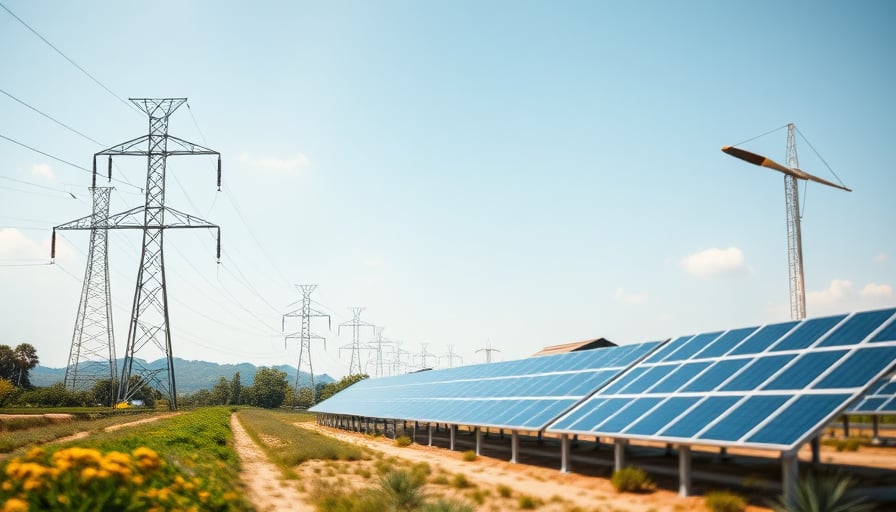Corporate Insights on Sempra Energy’s Upcoming Q3 Earnings and the Broader Power Market
Sempra Energy, a leading utility and infrastructure firm, is poised to announce its third‑quarter earnings in the coming weeks. While the company’s share price has remained largely stable—oscillating within a narrow band and exhibiting no dramatic uptick or downturn—the forthcoming financial report is expected to clarify its operational performance, especially in light of the recent commentary from analyst Jim Cramer lauding the CEO’s leadership. This corporate development occurs against a backdrop of significant shifts in the power generation, transmission, and distribution sectors, and has implications for grid stability, renewable integration, and investment strategies.
1. Power System Dynamics in the Context of Corporate Reporting
1.1 Generation Portfolio Shifts
Sempra’s generation mix includes natural‑gas combined‑cycle plants, peaking units, and a growing portfolio of renewable assets such as wind farms in Texas and solar arrays in California. The Q3 earnings will likely detail capacity utilization rates and output revenue, offering insight into how the company is balancing the intermittency of renewables with the reliability of fossil‑fuel baseload generation.
1.2 Transmission and Distribution (T&D) Infrastructure
The company operates an extensive transmission network that spans over 20,000 miles of high‑voltage lines. In its earnings narrative, Sempra is expected to disclose investments in high‑capacity FACTS (Flexible AC Transmission Systems) and HVDC (High‑Voltage Direct Current) converters, which are pivotal for enhancing line capacity and mitigating voltage stability issues. Moreover, the integration of distributed energy resources (DERs) into the grid—such as rooftop photovoltaics and community microgrids—requires sophisticated substation upgrades and smart‑grid technologies. The earnings report will likely cover capital expenditures (CapEx) earmarked for these upgrades, reflecting the broader industry trend toward digital T&D solutions.
2. Grid Stability and Renewable Energy Integration
2.1 Frequency and Voltage Regulation
With the increasing penetration of variable renewable resources (VRR), maintaining grid frequency within ±0.02 Hz and voltage within ±5 % of nominal values is more challenging. Sempra’s operational data will shed light on the deployment of synchronous condensers and power‑electron converters that provide inertia emulation and fast frequency response—critical for preventing cascading outages.
2.2 Energy Storage and Demand‑Response
The company has recently expanded its battery storage portfolio, with installations such as the 150 MW/600 MWh facility in the San Diego area. These assets act as both frequency regulation providers and peak shaving tools, allowing the firm to better align supply with demand during high renewable output periods. The earnings commentary will likely address performance metrics like round‑trip efficiency and degradation rates, which influence long‑term cost forecasts.
3. Infrastructure Investment Requirements
3.1 Capital Allocation Trends
Across the U.S. utilities sector, CapEx has surged as firms upgrade aging lines and integrate new technologies. For Sempra, a detailed CapEx breakdown in the Q3 report will illustrate how much is directed toward grid hardening, DER integration, and renewable acquisition versus debt servicing and dividend payouts.
3.2 Return on Investment (ROI) Calculations
The earnings release will probably include projected return on equity (ROE) and net present value (NPV) analyses for major projects. For example, the installation of a 500 MW solar farm in Arizona may be justified by a 9‑year payback period when factoring in state incentives and the projected cost of avoided transmission upgrades.
4. Regulatory and Rate Structure Landscape
4.1 State and Federal Policies
Sempra operates in multiple jurisdictions, each with distinct policy frameworks. The company’s financial disclosures will likely touch on the impact of the California Climate Investments program and Texas’s open‑market electricity rules, both of which shape investment decisions and revenue streams.
4.2 Rate Design and Consumer Costs
Rate structures—time‑of‑use tariffs, demand charges, and renewable surcharges—directly affect consumer bills. The Q3 report may discuss how Sempra is balancing cost recovery with regulatory compliance, especially as the state of California moves toward a 100 % renewable mandate by 2035. Any changes in rate design can alter the firm’s cost of service (COS) calculations, influencing future rate‑payer proposals to the Public Utility Commission (PUC).
5. Economic Impact of Utility Modernization
5.1 Cost of Service Adjustments
Modernization efforts—such as smart meters and automated load control—typically increase upfront CapEx but reduce long‑term operational expenditures. The earnings statement will likely provide a cost‑benefit analysis, highlighting how these investments affect the utility’s cost of service (C of S) and, consequently, rate‑payer charges.
5.2 Job Creation and Regional Economies
Large‑scale infrastructure projects create construction and operational jobs, stimulating local economies. The financial report may quantify job‑creation metrics and regional economic multipliers, which are increasingly important to regulators and investors alike.
6. Anticipated Implications for Sempra’s Stock Performance
While the stock price has shown relative stability, market participants are keenly awaiting the Q3 earnings to assess:
- Revenue Growth – Driven by higher renewable output and increased demand charges.
- Profitability Margins – Influenced by fuel cost volatility and capital intensity.
- Capital Expenditure Commitments – Reflecting the firm’s commitment to grid upgrades.
- Dividend Policy – A key determinant of investor expectations in a low‑yield environment.
A positive earnings surprise—particularly if revenue and profit surpass analyst estimates—could prompt a short‑term uptick in share price, while a cautious outlook may reinforce the current stability. Moreover, the company’s strategic narrative around grid resilience and renewable integration could enhance its long‑term valuation, especially as utilities are increasingly evaluated on sustainability metrics.
7. Conclusion
Sempra Energy’s forthcoming Q3 earnings release stands at the intersection of corporate performance and the evolving technical landscape of power systems. The report will not only reveal the firm’s financial health but also provide a window into its strategic priorities—grid modernization, renewable integration, and regulatory compliance—that shape both its operational trajectory and its influence within the broader energy market. Stakeholders, from investors to regulators, will closely analyze the data to gauge the company’s ability to navigate the challenges of a transforming power industry while maintaining grid stability and delivering value to consumers.
